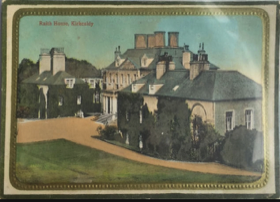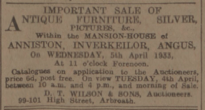Raitt residences
Besides Rait Castle of the early de Rathe family in Nairn, the Raitts and their descendants possessed other lands and properties, mainly in Kincardineshire and Angus. Several of these family seats, and stories associated with them, are described below, including Hallgreen Castle, Red Castle, Anniston House, Dunnottar Castle, Drumtochty, and Raith House.
----------
Hallgreen Castle
Writing in his Epitaphs & inscriptions from burial grounds & old buildings in the north-east of Scotland published in 1875, Andrew Jervise noted that Hallgreen Castle, in the immediate vicinity of the town of Bervie, is the chief object of antiquity in the parish. The oldest parts, as shown by dates and armorial bearings, were erected by Raits towards the close of the 16th and in the 17th centuries.
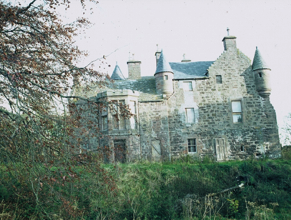
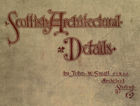
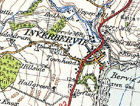
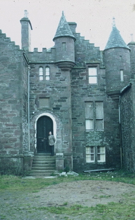
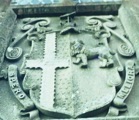
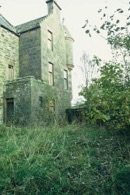
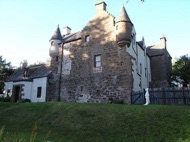
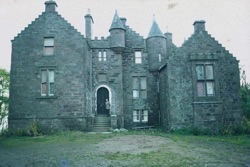
© above Eleanor and Clyde Moore
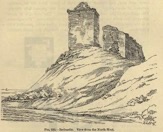
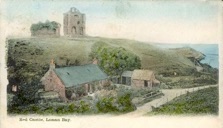

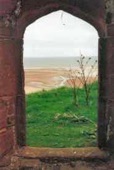
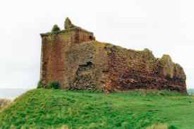
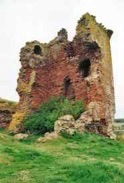
© images of Red Castle - Eleanor and Clyde Moore

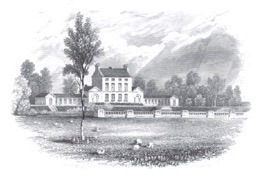
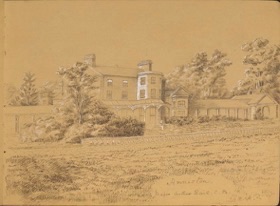
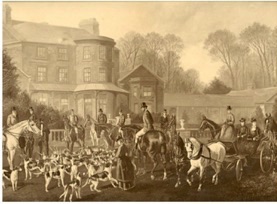
Anniston House
Courtesy: National Library of Australia
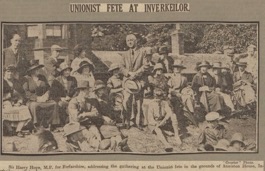
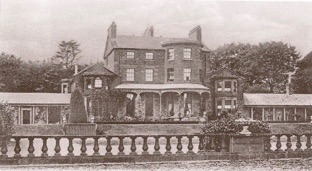
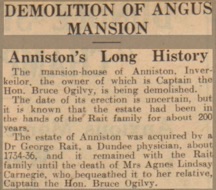
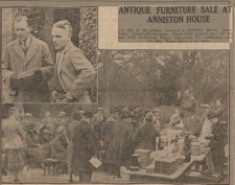
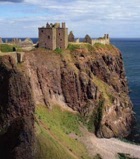
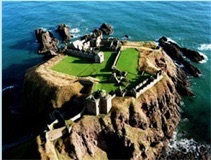
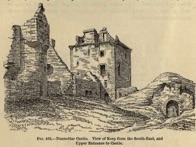
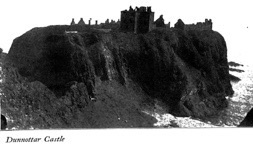
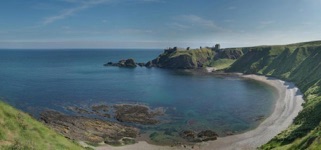
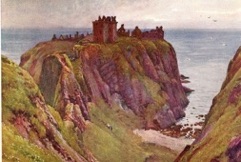
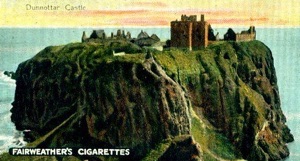
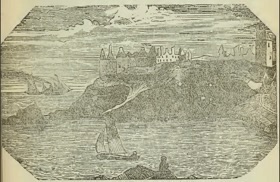
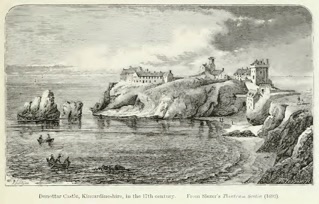
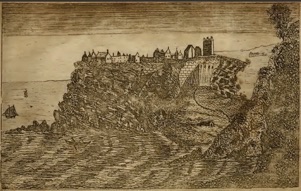
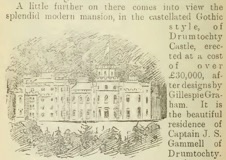
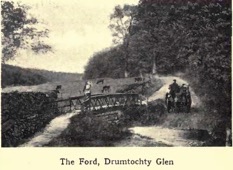
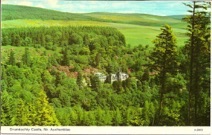


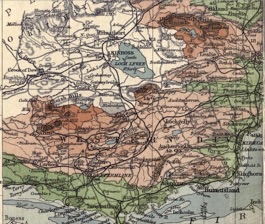
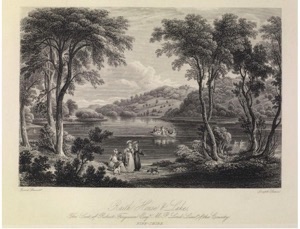
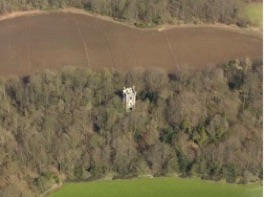
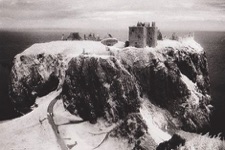
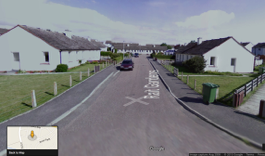
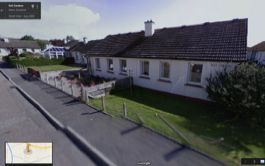

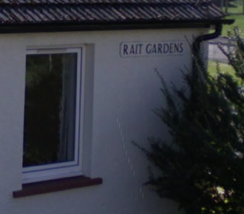
Rait Gardens
Mention must also be made of Rait Gardens in Nairn, a stone's throw from the sea. Not strictly speaking a residence of the Raitts, it has to be, nevertheless, named for the nearby lands of Rait, its Castle and perhaps even its family.
The Topograhical Dictionary of Scotland v1 (1813) mentions that Raith is the elegant and commodious Mansion of the truly respectable Family, of Ferguson; who have surrounded it with extensive Plantations, and otherwise adorned and enriched the Parish by their general benevolence and patriotic exertions. Robert Ferguson, Esq., the present proprietor of Raith, has added greatly to the beauty of the place by an extensive artificial Lake.
In the New Statistical Account of Scotland for Abbotshall parish, Fife, dated 1836, it is noted that: “Raith, anciently the seat and possession of the Earls of Melville, now the property of Robert Ferguson, Esq. M. P. is by far the most considerable estate in the parish, being more than equal in value and extent to all the rest of the parish together. The mansion-house was originally built in the year 1694, by Lord Raith, Treasurer Depute, and must have been at that time a substantial good house. Its length is 72 feet, and its breadth 40. To the original house were added two wings, during the time of the late Mr Ferguson, which made the accommodation very complete, and such as became the mansion-house of so fine an estate as Raith. A few years ago, the present proprietor attached to the front of the house a fine Ionic portico, which gives to the whole a light and elegant appearance. In the interior of the house, what principally claims attention is the library, which contains a well chosen assortment of books, both ancient and modern, — and a cabinet of minerals, which, for richness and extent, is surpassed by few private collections of the sort in the kingdom. The situation of the house is noble and commanding, and the extent of plantations and pleasure grounds which surround it is very considerable. Near the summit of the hill on which the mansion-house is seated, and perhaps 400 feet above the level of the sea, stands the tower, which is a square building, with an inside stair of 54 feet in length. From the top of this tower so extensive is the view, that not less than parts of fourteen, some say sixteen, different counties can be distinctly pointed out in a clear day.”
Further information is provided in History of the county of Fife: from the earliest period to the present time by John M Leighton v3 (1840). “From the extensive pleasure grounds around Raith House, which are varied by wooded hills, deep valleys, and fine open lawns. The largest proprietor in the parish is Robert Ferguson, Esq. of Raith, M.P. for the Kirkaldy district of burghs, and Lord Lieutenant of the county of Fife. He sat in the House of Commons for the county of Fife in 1806, for the Kirkaldy burghs from 1831 to 1834, for Haddingtonshire from 1835 to 1837; and was that year again returned for Kirkaldy. His mansion house of Raith is situated amidst extensive pleasure grounds of the most beautiful description, upon the summit of a considerable hill near the centre of the parish. Of this finely situated mansion house, with its wooded grounds and beautiful lake, a view is given, taken from the south. The house is said to have been built in 1694, by Alexander Lord Raith, then treasurer-depute, and must have been an excellent house for the period. The late Mr Ferguson of Raith increased the accommodation by adding a wing to each end; and the present proprietor added considerably to its appearance by erecting in front a fine Doric portico as an entrance. The library of this house contains an extensive and well chosen collection of books both ancient and modern, and a cabinet of minerals, which for richness and extent is surpassed by few private collections of the kind in the kingdom. The estate of Raith appears to have belonged as early as 1296 to Sir John de Melvill, who that year swore fealty to Edward I. Sir John Melville of Raith, the ninth in descent from the first proprietor, was a favourite with James V., and was by him appointed master-general of the ordnance, and captain of the castle of Dunbar. He was among the first men of note in Scotland who embraced and favoured the reformed religion. He was in consequence of the enmity of the Catholic clergy tried for high treason and executed in 1549; and his estates forfeited, and his family reduced to great distress. He was the father of five sons who were all eminent during the reign of Queen Mary, and the Regency which followed her resignation of the crown. The eldest son John Melville of Raith was restored to his father's estate by the queen regent about 1553, at the special request of Henry II. of France.
John Melville of Raith, the grandson of John Melville, to whom his father's estates were restored, succeeded his cousin Robert, Lord Melville, and became third Lord Melville. His son George, fourth Lord Melville, was created first Earl of Melville, and was ancestor of the present Earl of Leven and Melville; of this eminent nobleman a short account has also already been given. His eldest son Alexander, Lord Raith, was a nobleman also of great talents, and is alleged to have built Raith House. He was treasurer-depute, and had the management of the public revenues from 1689 till his death in 1698. He died without issue before his father, so that his second brother David succeeded to the earldom of Melville, and afterwards to that of Leven, through his mother. Shortly after the death of George first Earl of Melville, the estate of Raith passed into the possession of the ancestor of the present family.
Now forming part of the estate of Raith are the lands of Abbotshall, anciently belonging to the monastery of Dumfermline; and afterwards to the Scotts of Balwearie.
Similar detail is afforded in A Descriptive and Historical Gazetteer of the Counties of Fife, Kinross and Clackmannan by M. Barbieri and published in 1857: “The house of Raith was originally built by Lord Raith, in 1694. It stands near the summit of a hill, perhaps 400 feet above sea-level, almost in the centre of its fine gardens. Its length is 72 feet, by 40 in breadth. It contains a fine library, filled with ancient and modem books; besides a rich cabinet of minerals. Near the house stands the tower, a square building, with an inside stair 64 feet in length, from the top of which a noble and extensive view is obtained. As early as 1296, the estate of Raith had belonged to Sir John de Melvill. We find a descendant of Sir John in the person of Sir James Melvill, whose Memoirs are quoted in this work. Abbotshall forms part of the Raith estate. From the Abbots of Dunfermline, Abbotshall passed to the Scotts of Balwearie, in whose family it remained, according to Sibbald, during 600 years, and then was purchased by Sir Andrew Ramsay, a merchant, and provost of Edinburgh in 1664 and 1667.
Raith House
Given the various earlier forms of Raitt/Rait such as de Rathe, then it is likely that the name Raith is kindred to Raitt. The precise origin appears to be unknown, but may be taken from the word rath, of course. The Battle of Raith (not to be confused with Raith in Ayrshire (see under Other Raitt Locations) in the year 596, fought between the Angles and an alliance of Scots, Picts and Britons led by King Áedán mac Gabráin of Dál Riata, is believed to have taken place a mile or so to the west of Kirkcaldy in Fifeshire.
The location and name were obviously remembered a thousand years later, when a fine mansion, Raith House, with a large estate (Raith Park) was built by Alexander Ferguson, Lord Raith, between 1692 and 1694, the work of that time being represented by the central portion of the present house, oblong on plan. The old house has been altered, but the ground floor vaulting remains. The outside walls are harled but the dressings are left exposed. Raith Tower to the west of Raith House is a 19th-century folly. Robert Ferguson of Raith (1767-1840), a Member of Parliament and Lord Lieutenant of Fife, is remembered for having a scandalous affair with Lady Elgin and being successfully sued for £10,000 by Lord Elgin of Elgin Marbles fame. Raith remains in the same family, now the Munro-Fergusons. Raith lends its name to Raith Rovers, a local football team.
A very full account of the Raith estate (from which below is a brief summary) which comprises several listed buildings including Raith House, Raith Stable Court and Home Farm, Raith Tower and Raith Walled Garden is provided in An Inventory of Gardens and Designed Landscapes in Scotland. Raith House, designed by James Smith 1694, is a two-storey and vaulted basement, seven-bay Palladian mansion, with a carved pediment. James Playfair (architect for Anniston House in Inverkeilor in Angus which belonged to the Rait family - see above) added pavilions and quadrant links in 1785, when the interior was remodelled. A porch was added to the main, north entrance sometime after 1895, replacing an Ionic portico of c. 1800 as well as a balcony on the south. The Stable Court and Home Farm, was also designed by James Playfair about 1785. It is rectangular in plan, a classical stable-court around a central courtyard. The south front, of squared and snecked dark whinstone rubble, is pedimented with niches for statues (some now removed). The other facades are coursed rubble with ashlar sandstone dressings. Internal to the courtyard the ranges are formally treated, many with cart arches. The Laundry House, probably contemporary with the Stable Court, is a single and two-storey, seven-bay piend-roofed house of dark whinstone rubble with dressed ashlar sandstone quoins and dressings. Raith Tower, an early 19th century, three-storey square-plan, crenellated lookout tower of harled brick, stands on Cormie Hill. Other structures within the landscape, also dating to the early 19th century are the Ice house, constructed as a three-storey circular tower with a crenellated turnpike stair-tower atop a mound (its upper stages form a game larder) and a segmental-arched rubble Bridge over the Dronachy Burn, carrying the main south drive. An Ashlar altar-tomb on granite base, in memory of Colonel Robert Munro Ferguson of Raith and Novar, dated 1868 is situated on Castle Hill, one of the highest spots within the Raith policies. Raith Lodge and Gateway were also designed by Playfair in 1786. Of the Walled Garden only the walls and gateways survive.
Meanwhile, from volumes 3 and 4 of the Illustrations of the topography and antiquities of the shires of Aberdeen and Banff by Joseph Robertson (published 1857) we find that the above Johanneum de Rate, Archbaldum de Rate and Henricum de Rate are all mentioned in connection with the service of Alexander Stewart as heir to Sir Andrew Stewart, his father, in the lands of Sandhalch, in the sheriffdom of Banff, and the lands of Culquhorsy, in the earldom of Mar - charter dated 1435 in the parish of Alvah. Somewhat later Archebaldum Rate de Drumtocty is a witness to a charter between Margaret Forbes, in name and behalf of Malcolm Forbes, heir to the deceased Alexander Forbes of Tochcone, and Alexander Tullache, in regard to the ward and relief of the lands of Tochcone etc - dated 1487 in the parish of Tarves. Also in 1487, Archibaldo Rate de Drumtocty was witness to a charter by King James III, confirming a charter by Beatrix of Dunbar, widow of the deceased Master Gilbert Hay of Ury, and the lady of Creichmond, to her son and apparent heir, William Hay of Ury, of her lands of the barony or lordship of Creichmond, in the sheriffdom of Aberdeen. Around the same time in 1487 in the parish of Crimond a contract was drawn up between William, earl of Erroll, lord Hay, and Constable of Scotland, Beatrix Dunbar, widow of the deceased Master Gilbert Hay of Ury, and William Hay, son and apparent heir of the said Master Gilbert Hay and Beatrix Dunbar, on the one part; and Archibald Rait Laird of Drumtochty, on the other part; for the marriage of the said William Hay with the daughter [Katherine] of the said Archibald Rait, and the entry of the said William Hay, by the Earl of Erroll, in the lordship of Ury, in the sheriffdom of Kincardine, and in the fee of the lands of Crechmond, in the sheriffdom of Aberdeen. The document was issued under the name of Archbald of Rat of Drumtocte. A year later, a contract was drawn up in the parish of Gamery in 1488 whereby Archebald Rat of Drumtochty sold to George Forbes of Auchintoul, three parts of the lands of Pratistone, Crove and Hannyhill, in the barony of Troup, and his third parts of the lands of Munane and Dradleane, in the barony of Doun (both baronies in Banffshire). The charter was witnessed by Archibald’s son Robert Raite, amongst others.
In the Liber S. Thome de Aberbrothoc which contains the charters and documents recorded in the Older Register of Arbroath Abbey, we find that number 332 dated 9 July 1491 mentions the names of David Rait of Drumnagar, Archibaldum Rait de Drumtocti, and Robertum Rait.
A descendant, Roberto Rate de Drumtokty, is mentioned in a document dated 28 February 1602.
The Old Castle of Drumtochty, near Auchenblae and Laurencekirk, Kincardineshire, is thought to have been a tower house which was superseded by the nearby house of Woodstock, built around 1755, and later incorporated into the new Drumtochty Castle, erected about 1812, altered in 1815 and again in 1839. Surrounded by forest, the neo-gothic style, castellated mansion was apparently bought by the Norwegian government in exile during the 2nd World War and used as a boarding school for Norwegian children who were refugees from the German occupation of Norway.
There is also mention of the castle in the Statistical Account of Scotland, Vol. XI, dated 1774. “The Castle of Dunnotter is now in ruins.—It is situated on a perpendicular rock, level on the top, of several acres extent, projecting into the sea, and almost separated from the land by a very deep chasm. By this situation, it forms one of the most majestic ruins in Scotland. From some old papers still extant, it appears, that upon this rock was formerly situated the parish church; and that the fortress was built there, during the contest between the parties of Bruce and Baliol. by an ancestor of the Marischal family; who acquired this right, upon condition of building a parish church in a more convenient place, which probably occasioned a translation to the present situation. Before the use of artillery, this castle, from its situation must have been altogether impregnable; but, by the modern art of war, could be easily approached, and commanded on every side. In the year 1685, Dunnottar Castle was employed as a place of confinement for a body of Presbyterians, to the number of 167 men and women who had been seized at different times in the west of Scotland, during the persecution under Charles II.; and after being some time prisoners in Edinburgh, were sent to Dunnottar upon the news of Argyll's invasion. Here they were treated with the greatest cruelty, which is particularly described in Woodrow's History; the whole number being confined, during the warmest part of the year, in one vault, which is still to be seen entire, and called "the Whig's Vault." A list of their names is upon record, in the sheriff-court office of the county; and a grave stone, in. the church-yard of Dunnottar, placed upon a number of them who died under confinement, narrates the fact The false policy of these times requires no comment; And it must afford satisfaction to every liberal mind to reflect that the principles of toleration are now fully established; which not only secure the rights of conscience to every individual, but also tend, in a high degree, to preserve the peace of society if not abused and perverted by factious and designing men.
Its great reputation for strength gave occasion to a circumstance which rendered it very remarkable. The Regalia of Scotland (the crown, sceptre and sword), were deposited here, in the year 1661, to preserve them from the English army, which overran this country during this civil wars of that period.
During the Commonwealth, Dunnottar Castle was selected, as the strongest fortress in the
kingdom, as a place of deposit for the Regalia of Scotland. They were deposited there by order of the privy council, and the Earl Marischal was furnished with a garrison, ammunition and provisions. As the English were extremely anxious to get possession of the insignia, General Lambert blockaded the fortress in 1652. When it became evident that the castle must finally surrender, the Dowager Countess Marischal devised a stratagem by which the jewels were saved. Mrs. Granger, wife of the minister of Kinneff, with her maid, had been permitted to visit Mrs. Ogilvy, wife of the lieutenant-governor of the castle. When she left, she carried the crown packed among some clothes which she carried in her lap, and her maid took the sword and scepter in a bag of flax on her back. The English general was so far from suspecting the ruse that he assisted the lady to mount her horse. So the precious insignia came safely through the English lines, and were buried under the pulpit of the church of Kinneff until the Restoration in 1660. The governor's son, the minister and his wife were all tortured after the surrender of the castle, but the secret was not betrayed. All parties asserted that the jewels had been conveyed to Paris by Sir John Keith, and the English were completely baffled. Though the garrison was permitted to march out with drums beating and colours flying, Ogilvy was long imprisoned in England for saving the regalia. He was eventually made a baronet by Charles II.
In 1685 Dunnottar was used as a prison for one hundred and sixty-seven Covenanters, who were crowded for a whole summer into two cellars, so closely that there was not room for them all to sit down at once. They were treated with the most atrocious cruelty, and many of them died of their sufferings. Twenty-five finally managed to escape, but most of them were recaptured, and tortured by inserting burning slowmatches between their fingers, and in other diabolical ways. After being confined here from May until September, they were sold as slaves to Scott of Pitlochy and embarked for New Jersey. Most of them died of fever on the voyage, as well as their owner and his wife.
James Raitt was minister at Dunnotar and the testament of his deceased wife, Elizabeth Allardyce, is dated 21 June 1688.
The path to the castle descends the steep cliffs of the mainland, and passes under defensive outworks on an outlying spur called the Fiddlehead. A flight of steps leads up to the base of a thirty-five-foot wall which fills a cleft in the rock, and is pierced by a narrow gateway, the only entrance to the castle. Behind the arch is a portcullis and a further flight of steps with five embrasures for guns at the top. At the top of the steps the roadway turns to the left and ascends twenty-nine feet. It then turns again at right angles to the right. Twenty-nine feet further on is a strong door, then a tunnel twenty-six feet long with another door at the further end, and more open roadway. Another tunnel of the same length is also defended by doors at each end, beyond which the top of the rock is reached. All the open passages are commanded by buildings on both sides and high rock slopes, so that the passage is as impregnable as could be imagined. The oldest part of the buildings on the platform is the keep, of the first part of the fifteenth century, at the southwest corner. It is L-shaped, and four stories high. The internal arrangements are similar to other keeps of the period. The parapet is carried on corbels and machicolated. To the east of the keep are storerooms and stables, built at a later date, when the keep became too small. Near these buildings is a sixteenth century structure containing a hall and private apartments, and called the Priest's House. The increasing wealth of the family caused the erection late in the sixteenth and early in the seventeenth century, of the very extensive quadrangle at the northeastern comer of the rock. This contained all the apartments necessary for a very large establishment conducted on the most sumptuous lines.
In 1297 four thousand Englishmen retired into Dunnottar Castle to escape from Sir William Wallace. He scaled the crag and entered by a window, opened the gates, and let in his troops, who slaughtered the garrison to the last man. In 1336 Edward III refortified Dunnottar during his progress through Scotland, but it was retaken by Sir Andrew Moray as soon as he left the kingdom. It later came into the possession of the Keiths, Earls Marischal, and had an uneventful history until the civil war. It was then besieged by the Marquis of Montrose, the Earl Marischal being a Covenanter, and having given refuge to sixteen covenanting clergymen. The Earl rejected Montrose's terms of surrender, and in consequence saw all his properties on the mainland burnt and wasted. As the smoke rolled up in clouds, he deeply regretted his resolution, " but the famous Andrew Cant, who was among the number of his ghostly company, edified his resolution at once to its original pitch of firmness, by assuring him that that reek would be a sweet-smelling incense in the nostrils of the Lord, rising as it did from property which had been sacrificed to the holy cause of the Covenant."
© Carolin Liefke © Stephen Evans
Of the more modern clergymen of the parish little of interest has been learned; and in regard to the history of the property of Dunnottar, which included the craig or rock upon which the old church stood, it may be briefly observed that after the death of the Earl of Sutherland, who fell at Halidon in 1333 while commanding the van of the army, it was acquired by Matthew of Gloucester. He was afterwards proscribed, and about the year 1341 Rait of Uras, who was the king's shield-bearer, acquired certain portions of the property. Rait was succeeded by Sir William Keith, who married the heiress of Fraser of Cowie ; and, on the marriage of their daughter Christian with Sir William Lindsay of the Byres, Lindsay received the lands and craig of Dunnottar from Keith. Soon afterwards, Lindsay exchanged these possessions with his father-in-law, for the lands of Pittendreich, in Stirlingshire, and not long after, it is said, Sir William Keith built a castle upon the rock of Dunnottar.
----------
According to The castles and keeps of Scotland by Frank Roy Fraprie, published in 1907 Dunnottar Castle stands on a plateau of rock projecting into the German Ocean, two miles south of Stonehaven. This plateau is at the average level of this part of the coast, about one hundred and sixty feet above the flow of the tide, and is isolated from the mainland by a deep and wide cleft. As its precipitous walls are washed by the sea on all sides except the west, and inaccessible except at one place on this side, the natural position is the strongest imaginable site for a fortress. The resources of art have been added to those of nature to form one of the most extensive and important castles of Scotland. The area occupied by the structure is more than three acres. At the end of the thirteenth century the rock was occupied by a parish church. Sir William Keith, perceiving the possibilities of the spot for defence, built a tower here, and was excommunicated by the Bishop of St. Andrews for building on sacred ground. The case was referred to Rome, and on July 13th, 1394, Pope Benedict issued a bull, ordering the bishop to remove the excommunication. The property was abandoned to secular use, and Sir William was obliged to build a new church in a more convenient location. He obtained the estate of Dunnottar from Lord Lindsay of the Byres in exchange for Struthers in Fifeshire, about 1390, and these two events serve to fix the date of the first building at Dunnottar.
In the History & Tradition of the Land of Lindsays in Angus and Mearns by Andrew Jervise first published in 1853 with a second edition in 1882, it is noted that during the ownership of Lindsay, and down to the year 1390, there was no castle at Dunnottar such as was raised at a later date, yet in 1336 it must have been a fortified place, when Sir Andrew Moray, the Regent, took the fortalices of Kinclavin, Dunnottar, Kinneff, and Laurieston after the departure of the English king, and levelled them to the ground.
In the reign of David II, Thomas Rait of Uras, who was the King's Shield Bearer, acquired certain property in the parish of Dunnotar. of which mention is made of King Robert II granting confirmation in 1383. “In the 12th year of the reign of Robert II, Thomas de Rate was granted a charter of the lands of “Ures, Clathok, Hiltoun, and Katerlyne, the brewhouse of Denhouse, Lumgerr, the miln of Dunnotter, and part of the lands of Dunnotter, whilk Matthew de Glacefter forisfecit.”. Dunnottar had been the property of the Earls of Sutherland (William, fifth Earl of Sutherland, on 30 March 1346, had a charter from King David II of the Crag of Dunottar) who were succeeded there by Matthew de Gloucester – of whom or his family nothing is known beyond the fact that, through disloyalty, he forfeited the Uris part of his property. Long prior to this, however, in 1341, Gloucester had resigned Dunottar into the hands of Thomas Rait, who, about this time, became a large proprietor in the Mearns – a fact which proves the family to have been settled in the district at least half-a-century before the time ascribed to them by Nisbet. The latter states that the name was originally brought to the district in Robert III’s time, by a fugitive knight (de Rathe), who had killed the Thane of Calder and fled for protection to Keith-Marischal, and his son marrying the heiress of Halgreen, his descendants subsisted there to the close of the seventeenth century. It was not, therefore until the resignation of Rait, which occurred during the last half of the fourteenth century, that the Keiths had any connection with Dunottar.
Sir William Keith, in the year 1354 designed “Marescallus Scotiae”, was the father-in-law of Sir William Lindsay. He married Margaret Fraser, daughter of the Thane of Cowie. Margaret was the granddaughter of Sir Alexander Keith and Lady Mary Bruce, daughter of Robert the Bruce. In the reign of Robert III, on 8 March 1392, Sir William Keith and his wife, made an excambion (exchange) of the lands of Pittendreich and those of Uchterutherstruther (now Crawford Priory) and Wester Markinch in Fife for the barony and castle of Dunottar in Kincardineshire, then belonging to Sir William Lindsay of the Byres, the latter reserving an annual payment of £8 from Dunottar. (Interestingly, Sir William had a "servant" - probably more of an administrator since he handled money and receipts - named Symon Rate (Raitt), who may possibly have been related to Thomas de Rate.) The Marischal must have acquired the castle and lands of Dunottar, thenceforward the principal family seat, at or shortly before the date of his marriage (though it is also said that he married before 1351). Around 1394 he demolished the chapel which stood on the craig, or rock, of Dunnottar and erected a castle there in its place on the cliff overlooking the sea.
Dunnottar Castle
Like the other castles inhabited by the Raitts at some point, Dunnottar Castle in The Mearns has seen its share of history. The site on which the Castle sits has been inhabited since Pictish times (as early as 5000 BC) - indeed the name Dunnottar stems from the Pictish word "Dun" which means hill fort or place of strength and the latter element meaning slope. In the 5th Century St Ninian brought Christianity to the Picts, and chose Dunnottar as a site for one of his chain of Churches. During the 9th Century, King Donald II was killed defending Dunnottar Castle from a Viking invasion which saw the Castle seized and destroyed.
Following the death of Arthur John Rait in 1902, the ownership of Anniston House passed to his daughter Eileen, and following her own early and untimely death in 1904, the house and estates were succeeded to by her aunt (and sister of Arthur John) Mrs Agnes Lindsay Carnegie - though Kathleen, Arthur John’s wife continued to live there until her death in 1923. Mrs Agnes Lindsay Carnegie of Anniston, Arbroath’s woman burgess, was one of the best known ladies in the county of Angus. She was the last in the line of the Raits of Anniston. Upon her death in 1932 she bequeathed to her cousin, Captain Bruce Ashley Ogilvy, brother of the Earl of Airlie, the life rent of the estate of Anniston, Inverkeilor, and the residue for ten years, and if alive at the expiry of ten years he was to succeed absolutely to the estate. In 1933 there was a sale of the antiques, silver, china and pictures in Anniston House and quite possibly the great Anniston Family Bible bible was included in this sale. In the Dundee Courier for Tuesday 8 October 1935 it was announced that the mansion-house of Anniston, Inverkeilor, the owner of which is Captain the Hon. Bruce Ogilvy, is being demolished. The date of its erection is uncertain, but it is known that the estate had been in the hands of the Rait family for about 200 years. The estate of Anniston was acquired by a Dr George Rait, a Dundee physician, about 1734-36, and it remained with the Rait family until the death of Mrs Agnes Lindsay-Carnegie, who bequeathed it to her relative Captain the Hon, Bruce Ogilvy.
A more recent description of Anniston House is provided by Fiona Scharlau in her book Angus (published by the History Press in 2009) which comprises a selection of over 200 historic photographs. The caption under the image (reproduced below) notes “Another lost building is Anniston House near Inverkeilor, a large country house set in an estate of 978 acres. It was built around 1786 for the Rait family, and was most likely designed by James Playfair, who designed other properties in Angus such as Farnell Church and Forfar Town House. Only the gatehouse and a walled garden remain today.”
James Playfair was born in Benvie near Dundee in 1755 and died in Edinburgh in 1794. He was from an illustrious family - his grandfather James had been the minister at Liff and Benvie, Angus, as was his father John; his brother John was an eminent scientist and mathematician, while his brother William was an engineer. James’s son, William Henry Playfair, became an ever better known architect than his father. Besides Anniston House and Forfar Town and County Hall (1784), James Playfair also built the parish church in Kirrimeuir (1786) and, most interestingly, was architect for extensions in 1785 to Raith House (see below) in Kirkcaldy, Fife, as well as the walled garden at Raith House in 1786 - where his brother John was tutor to Ferguson of Raith.
The present (1875) mansion-house of Anniston, which has been greatly improved by Mr James Rait, was previously called Little Inchoch, and the farm, now Myreside, was anciently Anniston. The 18th century house, with its estates and walled garden, is an elegant structure, consisting of a centre building, flanked with extensive wings. It occupies a beautiful situation on a fine piece of table land in the parish of Inverkeillor, about a mile south-east of the village, close by the road which leaves the Arbroath and Montrose turnpike road at Chance Inn, and leads to Ethie Castle. It was the residence of Colonel Arthur John Rait of Anniston C.B. (d. 1902) who, as a Major won honours in the Ashantee War that carry into the present generation the honourable record of past times. Colonel Rait married the Honourable Kathleen Georgina Arbuthnott (1849-1923), granted the style and precedence of the daughter of a Viscount by Royal Warrant 1918, in 1877. Nowadays the house is a ruin.
Anniston House
The Raits of Anniston claim descent (Burke's Landed Gentry) from the Raits of Hallgreen, an account of whom is given in Nisbet's Heraldry. In the reign of King Robert III, Sir Archibald Rait, of that ilk, for the slaughter of the Thane of Caddell, was forced to fly from that part of the country (Nairn), and live in the Mearns. The Raits in the Mearns became small proprietors and clergymen during the seventeenth century. Major Rait of Anniston, near Inverkeilor, was the representative of the latter branch. William Rait of Halgreen’s younger brother, Dr. George Rait (progenitor of the Forfarshire family), purchased Anniston in 1732 following the sale of Halgreen in 1724. It is said that the first Rait of Anniston - who also owned Balmadies at one time - acquired a fortune as a merchant in Dundee. On the Estate of Balmadies, the property of Mr. Rait, of Armiston, is a Cemetery, with many tomb-stones still remaining; but (in 1813) the Chapel has long been demolished.
Anniston House was described as being a fine mansion, comprising a centre house, three storeys in height, four windows in each, flanked with two long ranges of one storey, each containing seven windows in front, and terminating in two wings, those in the middle being higher than those at the extremities, with a large window in each of the four gable-ends. It was erected by John Rait, Esq., father of the present laird, on a beautiful terrace, with gardens at the base in front, amid a finely wooded demesne, on the north bank of the Keillor, about a mile south of the village of Inverkeillor, and about six miles north-east of Arbroath.
Forfarshire Illustrated (1843) describes Anniston House, the seat of James Rait, Esq, thus:
This mansion occupies a beautiful situation in the parish of Inverkeilor, at nearly a mile south of the village, by the road to Ethie and the coast. The accompanying view will convey a better idea of this residence and the surrounding grounds than any description we can give. The principal part of the estate lies at some distance from the house, being separated from it by the intervention of part of the barony of Redcastle. That part of the estate which includes the house, pleasure-grounds, and home farm, seems at one time to have been a separate property, as it was formerly known by the name of Little Inchock, to distinguish it from Meikle Inchock, which is situated immediately to the south of it, on the opposite side of Keilor Barn, but within the barony of Redcastle. One of Mr Rait’s ancestors was a magistrate in Dundee at the middle of the century before last; and another, we believe, was minister of Inverkeilor at the beginning of last century.
According to Fraser's " History of the Carnegies of Southesk," the last inhabitant of Redcastle was the Rev. Mr James Rait, of the family of Rait of Hallgreen, in the Mearns, who, at the Revolution in 1688, was Episcopal minister of Inverkeillor. When deprived of his living he took up his residence in the square tower of Redcastle, and continued to perform religious services for the parishes of Inverkeillor and Lunan. (See also under Religious Raitts)
Only a part of the 15th century rectangular tower and keep, and the two-metre thick east curtain wall (possibly dating from the 13th century) remain. A midden below the castle has yielded a number of artifacts that are now in Montrose Museum.
Red Castle
Looming over the waters and sands at Lunan on the hill overlooking the beach, Red Castle was a former Royal pleasure palace built on the orders of King William the Lion in the late 12th Century as a fortress and a preemptive measure against Viking invaders. Not to be confused with Roy Castle, also known as Redcastle, in Inverness-shire, it ended up being one of King William’s favorite hunting lodges during the latter part of his reign. In 1194, William conferred the castle and the land surrounding the village of Inverkeilor to Walter de Berkeley, the Royal Chamberlain. It was officially called "rubeum castrum”, or Red Castle in deeds of 1286 - the appellation referring to the red sandstone from which it was built. It later returned to the royal family and in 1328 was given to the Earl of Ross by Robert the Bruce. Around 1580, the castle fell into decline and although it remained partially roofed until 1770, it was no longer the center of power or of any importance for kings and cardinals.
According to the architects McGibbon and Ross (see under Rait Castle) “Redcastle occupies a very ancient site, overlooking the German Ocean, at the mouth of the Lunan Water, a few miles south from Montrose. A castle was erected here by William the Lion as a hunting seat, and it is possible that the fragment of the ancient and massive wall of enceinte still existing may be a part of the original fortress. The keep has been of the ordinary quadrilateral figure, the foundations all of the whole being still traceable, but only the north gable and parts of the side walls now remain. These walls are of nearly the original height, and have been crowned with a parapet and angle bartizans, the double corbels of the former and the projecting corbelling to support the latter being still entire. The walls are faced with good red freestone ashlar. The above features indicate that this keep belongs to the fifteenth century.”
According to Nisbet in his System of Heraldry, during the reign of King Robert III, the first Rait, Sir Archibald Rait, of that ilk, took refuge in the Mearns during the 14th century under the protection of the Lord, Keith, having had to flee his native district of Nairnshire for the slaughter of the Thane of Caddell (see Rait Castle Owners). It is certain that Raits were settled in the Mearns, and held the lands of Owres or Uras and others at the period mentioned by Nisbet; but it was not until towards the close of the following century that they had any connection with Hallgreen. Sir Archibald’s son, Mark Rait, married the heiress of Hallgreen (see Raits of Hallgreen). (Nisbet seemingly acquired his information from the Families of Scotland complied some fifty years earlier - see under Raitt Name at bottom).
It appears from the inventory of the title-deeds of Hallgreen that the lands of Hallgreen were partly held under the Crown, and partly under the family of Arbuthnott. The oldest writ concerning the property shows that on 12 June 1478, James III. confirmed a charter by Alexander Menzies, burgess of Aberdeen, dated 21 January 1471, in favour of David Rait of Drumnagair, "of his Blench Lands of Inverbervie, commonly called Hallgreen, with Twa Ninth Parts of Inverbervie and their Roods, and Part of the Mill thereof”.
From the above period until the year 1724, the same family of Raits possessed Hallgreen; and from them all the Raits of any note in Angus and the Mearns, whether landholders, ministers, farmers, or merchants, claim to be descended.
Architects MacGibbon and Ross simply state that Hallgreen is “a modernized mansion, close to Bervie, which still retains a turret and a few other old details, including the date 1687. It belonged to the old family Rait of Hallgreen.”
Some of the Raits of Hallgreen married into the families of Gardyne, Douglass, Symmers, and Arbuthnott, The last laird, William, died about 1724, and the lands, burdened by mortgages, were sold by order of the Court of Session. The estate of Hallgreen again changed hands in 1799, with the Castle being restored by the present Laird about 1840. The Rait family-owned Hallgreen castle on the southern outskirts of Inverbervie in Kincardineshire is a fairly typical 16th century fortified laird’s towered house, originally built on an L-plan, although it has been added to on the west (front) and north sides. The fronts to south and east are old construction and an effaced date on the front of the castle is said to be 1376. The castle has a vaulted basement and gunloops for defence and looks as though it may have had a moat and drawbridge in earlier times. Hallgreen Castle is said to be haunted and there have been several sightings of servant girl ghosts in the basement, as well as a cloaked man. The spirit of a woman thought to have killed herself after her child died has also been seen.
Although not mentioned in the Old or First Statistical Account of Scotland for the parish of Inverbervie in 1794, Hallgreen is mentioned under Antiquities in the New Statistical Account of Scotland for Bervie dated 1837. “The old Castle of Hallgreen is situated at the southmost point of the Parliamentary boundary of the burgh, on an eminence near the sea, and is a large building. A date appears on the west front of it, considerably effaced, but supposed to be 1376. Its walls are very thick, and full of arrow-holes, and the stones in many parts appear much worn by the lapse of ages. There is every appearance of its having been surrounded by a moat, over which there had been a drawbridge with a portcullis near the outer gate of the court. Several additions appear to have been made to this castle at different periods. Above a door in the court, there is the date 1687, with the initials of a proprietor, Mr Raitt, who then occupied this mansion, and had made a considerable addition to it; and there is in one of the principal rooms, on the stucco-ceiling, a coat-of-arms, with the words spero meliora, and the date 1683. There are also some paintings on the old wainscots which lines the walls, which look like Dutch paintings, viz. two landscapes and a flower-piece. The modern part of this building is habitable, and is presently occupied by a family.”
Drumtochty
In volume 1 of Epitaphs and Inscriptions from Burial Grounds and Old Buildings in North-East Scotland by Andrew Jervise (published 1875) we read that Drumtochty belonged in old times to a branch of the Raits, afterwards of Halgreen, for about the year 1440, John Rait of Futhes (Fiddes) had a charter of the lands of Drumtokie, in Kincardineshire, and of the half lands of Campsie, in Angus, on his own resignation. Soon after that date, the said John Rait gave a charter of the west half of Drumtochty to his son Henry, and another of the east half to Thomas of Gillmouk. It also appears that Alexander Calder, son to Hew and Janet Ogilvie, his spouse, had a charter of Drumtochty, on the resignation of his father and of Elizabeth Rait, his spouse (MS. Notes of Scotch Charters at Panmure.)
